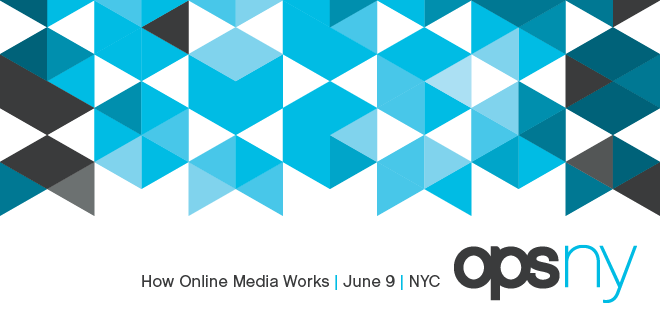
I’ve been in an OPS-induced coma for the past week, letting my subconscious ruminate over the titanic loads of digital media debate that took place in the hallowed chambers of the Metropolitan Pavilion on June 9. It was just too much for one mind to take, which I corroborate by slogging through the massive amount of #OPSNY tweets. Viewability, ad-blocking, non-human traffic, programmatic, linear-digital convergence were among the high-profile topics tackled, typically across multiple sessions. It was an exhausting affair, but I was able to extract some nuggets out of my frazzled mind.
• Linear-digital convergence is upon us, but holy cow, there’s a lot of work to do. ESPN worked with Sling TV for a full year before the February launch, and they’re still testing, testing, testing. The workflow is murky, as the dynamic ad insertion relationship between ESPN and Sling is “complicated,” as the Facebook generation might say. However, advertisers are increasingly excited by the potential (think targeting) for “programmatic TV,” whether through over-the-top devices or streaming services like Sling. On the other side, as digital-based and legacy print publishers pump up their video content, the lure of grabbing audience on the boob tube gets ever more enticing.
• Gavin’s suggested amount of espresso for a full day of OPS? Four double shots, occasionally supplemented with drip coffee.
• “If something is ‘trending,’ it has already trended.” Mashable’s Seth Rogin made a strong case for the plausibility of predicting virality in detailing the company’s Velocity product, which uses web crawlers alongside algorithms to find the topics and stories likely to grab users’ precious attention. In addition to fueling editorial efforts (“Velocity does not replace journalists, but empowers them through data”), the tool has been used to drive performance for Mashable’s content marketing program. The potential, though, seems limitless: as Rogin pondered, “Can you attach yourself to the influencer when he/she is influencing?” (Also, check out this new self-serve platform for Mashable’s clever and effective Lift Units.)
• “I love my audience, but f*** you, ad blockers – 20% of my revenue is gone.” Mike Germano, VICE
• GroupM’s Joe Barone dropped some pearls of wisdom during the closing viewability panel: “Viewability is proxy for exposure, exposure is proxy for engagement, engagement is a proxy for sales.” Integral Ad Science’s Michael Iantosca added that if viewability becomes the primary driver it is problematic, because it should be a means to an end – not the end. Barone agreed: viewability is not the end, but a stepping stone to trust and credibility – really, the validation the digital space has long desired?
• Another insightful quote: “We cannot ask the same people to solve the problems they created.” Mac Delaney, SMV Group (So I guess the Pottery Barn Rule doesn’t apply to digital media?)
• Yes, programmatic native sounds like an oxymoron, but it’s real and it’s a big leap for real-time dynamic creative. The latest update to the OpenRTB standard enables the manipulation of creative elements to allow publishers the ability to snugly fit ads onto their pages. You can probably imagine, this is a boon for mobile display advertising, where in-feed is a preferred tactic. And we’re only talking about the RTB side of programmatic; programmatic direct platforms can enable even more options depending on the publisher. Adoption of the latest OpenRTB has been sluggish, and eyes are on the DSPs (who then point their fingers at a lack of advertiser demand). Still, publishers need to incorporate programmatic native options (definitely RTB-related) sooner rather than later because the floodgates are likely to burst come third or fourth quarter.
• What’s to be done about ad blockers? Well, not all that much at the moment, but there is one big question publishers are mulling over: why don’t we stop serving content to users employing ad blockers – or offer them another way to pay for that “free” content.
• Saddest thing heard all day: “I remember fighting to get leaderboards on-site.” Rob Beeler, AdMonsters